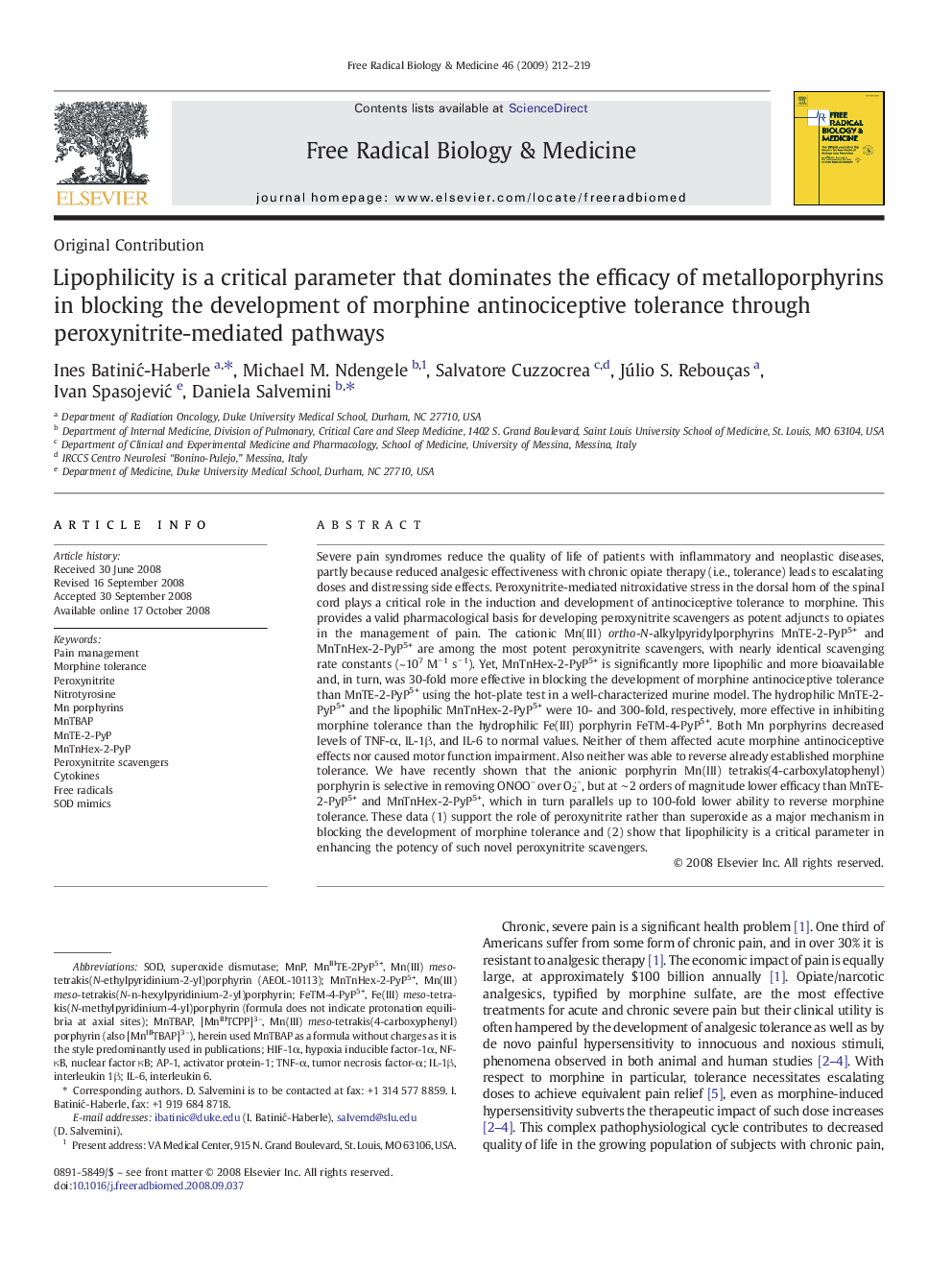| کد مقاله | کد نشریه | سال انتشار | مقاله انگلیسی | نسخه تمام متن |
|---|---|---|---|---|
| 1910466 | 1046772 | 2009 | 8 صفحه PDF | دانلود رایگان |
عنوان انگلیسی مقاله ISI
Lipophilicity is a critical parameter that dominates the efficacy of metalloporphyrins in blocking the development of morphine antinociceptive tolerance through peroxynitrite-mediated pathways
دانلود مقاله + سفارش ترجمه
دانلود مقاله ISI انگلیسی
رایگان برای ایرانیان
کلمات کلیدی
MnTE-2-PyPIL-6Mn porphyrinsMnTBAPIL-1βAP-1HIF-1αSOD mimics - SOD شباهت داردinterleukin 1β - اینترلوکین 1βinterleukin 6 - اینترلوکین 6Morphine tolerance - تحمل مورفینtumor necrosis factor-α - تومور نکروز عامل αFree radicals - رادیکال آزادSOD - سدSuperoxide dismutase - سوکسوکس دیسموتازCytokines - سیتوکین هاTNF-α - فاکتور نکروز توموری آلفاPain management - مدیریت دردnitrotyrosine - نیتروتیروستینactivator protein-1 - پروتئین فعال کننده-1Peroxynitrite - پروکسی نیتریت
موضوعات مرتبط
علوم زیستی و بیوفناوری
بیوشیمی، ژنتیک و زیست شناسی مولکولی
سالمندی
پیش نمایش صفحه اول مقاله

چکیده انگلیسی
Severe pain syndromes reduce the quality of life of patients with inflammatory and neoplastic diseases, partly because reduced analgesic effectiveness with chronic opiate therapy (i.e., tolerance) leads to escalating doses and distressing side effects. Peroxynitrite-mediated nitroxidative stress in the dorsal horn of the spinal cord plays a critical role in the induction and development of antinociceptive tolerance to morphine. This provides a valid pharmacological basis for developing peroxynitrite scavengers as potent adjuncts to opiates in the management of pain. The cationic Mn(III) ortho-N-alkylpyridylporphyrins MnTE-2-PyP5+ and MnTnHex-2-PyP5+ are among the most potent peroxynitrite scavengers, with nearly identical scavenging rate constants (~107 Mâ 1 sâ 1). Yet, MnTnHex-2-PyP5+ is significantly more lipophilic and more bioavailable and, in turn, was 30-fold more effective in blocking the development of morphine antinociceptive tolerance than MnTE-2-PyP5+ using the hot-plate test in a well-characterized murine model. The hydrophilic MnTE-2-PyP5+ and the lipophilic MnTnHex-2-PyP5+ were 10- and 300-fold, respectively, more effective in inhibiting morphine tolerance than the hydrophilic Fe(III) porphyrin FeTM-4-PyP5+. Both Mn porphyrins decreased levels of TNF-α, IL-1β, and IL-6 to normal values. Neither of them affected acute morphine antinociceptive effects nor caused motor function impairment. Also neither was able to reverse already established morphine tolerance. We have recently shown that the anionic porphyrin Mn(III) tetrakis(4-carboxylatophenyl)porphyrin is selective in removing ONOOâ over O2â, but at â¼Â 2 orders of magnitude lower efficacy than MnTE-2-PyP5+ and MnTnHex-2-PyP5+, which in turn parallels up to 100-fold lower ability to reverse morphine tolerance. These data (1) support the role of peroxynitrite rather than superoxide as a major mechanism in blocking the development of morphine tolerance and (2) show that lipophilicity is a critical parameter in enhancing the potency of such novel peroxynitrite scavengers.
ناشر
Database: Elsevier - ScienceDirect (ساینس دایرکت)
Journal: Free Radical Biology and Medicine - Volume 46, Issue 2, 15 January 2009, Pages 212-219
Journal: Free Radical Biology and Medicine - Volume 46, Issue 2, 15 January 2009, Pages 212-219
نویسندگان
Ines BatiniÄ-Haberle, Michael M. Ndengele, Salvatore Cuzzocrea, Júlio S. Rebouças, Ivan SpasojeviÄ, Daniela Salvemini,